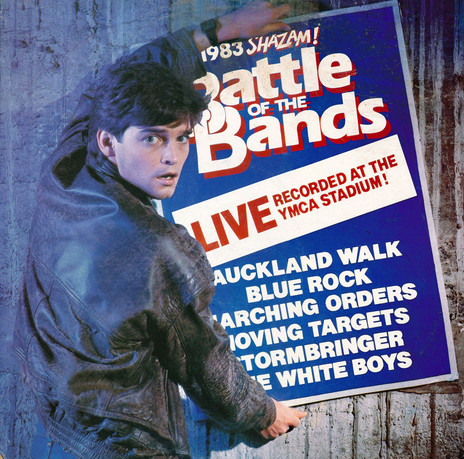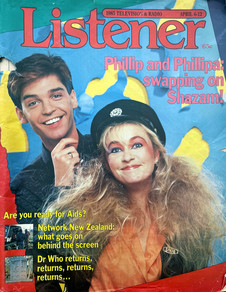In 1982 Television New Zealand had two long-running pop music shows. At primetime on Saturday evenings, Ready To Roll counted down the nation’s Top 20 record sales charts. Radio With Pictures was aimed at the more discerning music buff. It steadfastly held to its slot late on Sunday nights, catering to the stoners and other reprobates saying farewell to the weekend.
In April 1982 a third pop music show emerged from the Children’s Programming Department. Shazam! was aimed directly at the pubescent audience, or so it would seem, and it was Peter Grattan, who had earlier conceived Radio With Pictures, who was charged with creating it.

Phillip Schofield on the cover of the 1983 Shazam! Battle of the Bands LP
“I had been producing in the sports department,” Grattan remembers, “when I was commanded to devise a replacement for A Dropa Kulcha, which was TVNZ’s main children’s programme. A Dropa Kulcha featured lots of alternative bands which the powers-that-be deemed not quite suitable viewing at 5pm. So they decided on a change and in early 1982, with six weeks lead time, I was told to devise a new weekly pop series for the slot. This was the beginning of Shazam!”
Once again Grattan came up with a formula that worked, and one that lasted for five years in the mid-1980s. It made an overnight star of teenage English immigrant Phillip Schofield, the original presenter, and introduced New Zealand audiences to a new generation of local teenage acts, including Dance Exponents, The Mockers, and a young, ambitious in-your-face wannabe named Russ le Roq aka Russell Crowe.
“We auditioned dozens for the presenter’s job,” Grattan recalls. “Enter Phillip Schofield. The moment his audition started, he leapt through the screen at us in the control room. He’s larger than life, a natural, confident but not cocky, personable, knowledgeable, and funny. We knew we had our man, or boy, straightaway. We had our host!”
Schofield, aged 19, had arrived in Auckland with his family just months earlier and, with a strong focus on New Zealand talent, he had to quickly immerse himself into the local music scene. Precociously ambitious, he had worked for the BBC in London in a lowly capacity, which he exaggerated when auditioning for Shazam! His later confession did nothing to stall his employment. He became the face of Shazam!
Shazam! was so popular that the second series (1983) was extended to 60 minutes and it regularly featured live concerts with the top New Zealand acts of the day, notably the sell-out Shazam! Super Rock shows at the Christchurch Town Hall. There were annual events including a high-school pop video competition, a Best of The Buskers competition and a breakdance championship. Shazam! sponsored a battle of the bands and there were news and musical items from all parts of the country, quite regularly in Australia, and even as far afield as Great Britain.
Despite the show’s popularity, Grattan had a constant battle to improve the show. “It was a war that I invariably won,” he says, “but it was relentless. In the Facilities Department we had a guy we dubbed ‘The Programme Prevention Officer’. I’d have to beg and plead for things like a hand-held camera, a second VT machine, or a film crew.”

Shazam! creator and producer Peter Grattan with first host Phillip Schofield, c. 1982
A week before the first show went to air Cliff Richard was in the country, more to Grattan’s liking than the new show’s target audience. “EMI, Cliff’s record company, set up a five-minute interview, which lasted half an hour. Cliff opened up on so many topics we had enough material to produce a one-hour special, the first of many: Duran Duran (1983) and Culture Club (1984) in Sydney. Then come specials with Joan Armatrading, Billy Idol, Beatles photographer Dezo Hoffman, and Men At Work. When Split Enz split [for the first time] we moved fast to produce a one-hour doco on their farewell tour, directed by Brent Hansen, and a one-hour Enz With A Bang concert.”
Shazam! championed New Zealand talent, featuring a top local band every week. There is even a special with the NZSO playing pop. The show featured the debut TV appearances of acts such as The Gurlz, DD Smash, Peking Man, The Narcs, and Hattie & The Hot Shots. The Shazam! Super Rock live concerts were headlined by Dance Exponents, Hip Singles, Netherworld Dancing Toys, The Mockers and The Wastrels.
In late 1985, inspired by Live Aid and – “thanks to the visionary TVNZ head of programmes Des Monaghan!” – TV2 broadcast Rock On NZ, a four-hour live simulcast with cameras at Logan Campbell Centre and the Christchurch Town Hall. Eight bands including Hello Sailor played back and forth seamlessly, watched by massive audience.
“All the main record companies were Auckland-based, so arguably, making pop video shows in Avalon made little sense. Shazam! would often get the jump on RTR with new overseas videos, and RTR producer Peter Blake, whom I respected and admired, would get rather upset.
“I was lucky to have such talent available, truly blessed to be chosen to fill the slot. Phillip’s first pay cheques bought a Betamax home-video recorder and he’d get his young brother to record every show. I bet he still has them! He bought a Hillman Hunter and loved Barbra Streisand … but we forgave him.
“Skofe’s interviewing skills were excellent and he was articulate and a real pro. He and I did have one big fight, very silly, where he quit and I fired him … it got in the newspapers too, great publicity. But we amicably resolved the issue. I think it was to do with whose turn it was to make morning tea!
“By 1985, Shazam! was rating around 400,000 viewers a week. Phil’s family had reluctantly decided to return to the UK but he has a good gig and girlfriends – Marika, a beautiful Russian floor manager, then Fenella, an equally attractive ballet dancer – so he is happy to stay on in New Zealand.”
Until fate intervenes … “One Monday in April ’85, Phil enters the office very down. His dad had felt unwell at Sunday dinner, then collapsed with a massive heart attack. Phil saved his life by reviving him, medics arrived, but it changed his mind about staying in New Zealand.”
In June 1985, a trip to London was approved. Grattan hired a local crew there and managed to shoot backstage at Live Aid in Wembley Stadium. Many celebrity interviews were also booked, including Bananarama, Eurythmics, Fine Young Cannibals, Go West, Status Quo, Kim Wilde – and The Pogues (unusable as Shane MacGowan was drunk at 10am). “Luckily, Phil is already there, unemployed, so is hired. The 20 interviews appeared weekly through to Christmas, 1985. So Phil was still on, six months after he has left New Zealand!”
Schofield’s resume and showreel landed him a job at the BBC and he went on to become one of the UK’s foremost TV personalities. But that is another story …

Back in New Zealand, who could step into the very big shoes of Phillip Schofield? Grattan poached Pip Dann from Viewfinder in Dunedin, much to the anger of Hal Weston, head of the Childrens’ Department. Dann was a perfect replacement.
She recalls: “There was a couple months overlap before Phillip left, when we worked together and I was eased into the role and expectations so, by the time he left, I was up to speed with how everything worked, how the show ran and could take it on and make it my own.”

Phillip Schofield and Phillippa Dann of Shazam! on the cover of the Listener, 6-12 April 1985.
Does she remember interviewing Russell Crowe, then known as fledgling pop singer Russ le Roq?
“I had no intimation when I met Roman Antix and [the band’s singer] Russell Crowe that he would become a global legend. I don’t think you do when you’re young, in the moment and doing your job. He was terrifically confident, perhaps I should have read the signs better.
“And I have never met him since, even though you might think our paths would cross. I worked on film shows for MTV Europe for many years, covering Cannes, Venice film festivals, and film junkets coming through London, but I was never in Mr Crowe’s orbit.”
Dann’s first interview for Shazam! was with American heavy metal band Twisted Sister. “I remember feeling intimidated. They were full-on outlandish in appearance – for the time – they were American, they were heavy metal … But they were lovely, made my first job easy, they were kind to a rock’n’roll rookie, and – note to self – appearances can be deceptive.
“Simon Le Bon, lead singer of Duran Duran, came in for an interview. We may have nabbed him while he was on a sailing trip, perhaps shooting a video off the coast of New Zealand. Seemingly off duty from the day job of being a pop star. Not sure he was really that enthused about being in the Shazam! studio, but he was gallant. A professional.
“Most interviews were with New Zealand musicians. They might have given me a bit of stick because Shazam! was not Radio With Pictures, and all aspired to be on that show, but I have no lasting scars.”

Shazam! presenter Phillipa Dann interviews Duran Duran's Simon Le Bon, 1985.
It was during the strange “video wars” between TVNZ and the record industry of 1986 that Dann left the show. “There was no ‘official’ signing off,” she says. “I had been in London – to film interviews for Shazam! – and returned to find the record companies in dispute with TVNZ over payment for playing overseas music videos. The upshot was Shazam! and Radio With Pictures being taken off air. A replacement music show was put together, True Colours, co-hosted by Dick Driver [then host of RWP] and myself. This show played only New Zealand music – mostly video clips generated by TVNZ – thereby getting around the record company ban on playing music clips by international acts. My memory of this is that the show had a limited run, and by the time Shazam! returned, it was perhaps in need of a fresh look.”
Dann left New Zealand for the UK with her husband, Radio With Pictures director Brent Hansen, who in 1997 became chief executive of MTV Networks Europe. Michelle Bracey became the new host of Shazam! (and later a documentary director).
Dann says Shazam! was a show “I loved working on. I counted it a privilege to be part of the team who put the show together. There was no end of creativity and passion for the music, whether it was sourcing, listening to new music from artists outside New Zealand or giving access and a platform to musicians at home.
“Shazam! was aimed at an audience age from 10-17, made within the children’s department of TVNZ, so in essence, [it was] a teen pop programme. We worked within those boundaries, but like all teenagers tried to push the edges out when we could. There was nothing kiddy about the interviews and features but still keeping it in the family. I guess Shazam! was one of the windows at that time – the mid-80s in New Zealand – through which a young audience could gain access to pop stars, musicians, video culture. And the show was as much about being a fan, as the fans [who watched]. It wasn’t cynical: they were great people, and it was a great time to be part of the music scene. It’s humbling to remember – how lucky was I!”